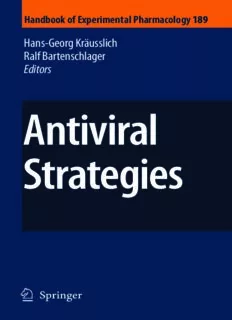
Antiviral Strategies PDF
Preview Antiviral Strategies
189 Handbook of Experimental Pharmacology Hans-Georg Kräusslich Ralf Bartenschlager Editors Antiviral 1 Strategies AB 3 Handbook of Experimental Pharmacology Volume 189 Editor-in-Chief F.Hofmann,München EditorialBoard J.Beavo,Seattle,WA A.Busch,Berlin D.Ganten,Berlin J.-A.Karlsson,Singapore M.Michel,Amsterdam C.P.Page,London W.Rosenthal,Berlin Hans-Georg Kräusslich Ralf Bartenschlager • Editors Antiviral Strategies Contributors J.Anderson,R.Bartenschlager,L.C.Bassit,C.Baum,B.Berkhout,C.A.B.Boucher, S. Chevaliez, S.J. Coats, E. De Clercq, S. Fleßa, J. Haasnoot, G. Hewlett, S.J. Hurwitz, H.-G.Kräusslich, S.-K. Lee, J. Lennerstrand, P. Marschall, T. Melby, B.Müller,J.H.Nettles,J.Neyts,M.Nijhuis,J.-M.Pawlotsky,U.Protzer,C.Schiffer, R.F. Schinazi, P.M. Schmidt, V. Soriano, R. Swanstrom, R. Thomson, N.M. van Maarseveen, M. von Itzstein, D. von Laer, H. Rübsamen-Waigmann, M. Westby, S.Zeuzem,H.Zimmermann ABC Editors Hans-GeorgKräusslich RalfBartenschlager UniversitätsklinikumHeidelberg UniversitätsklinikumHeidelberg HygieneInstitute HygieneInstitute DepartmentofVirology DepartmentofMolecularVirology ImNeuenheimerFeld324 ImNeuenheimerFeld345 69120Heidelberg 69120Heidelberg Germany Germany hans-georg_kraeusslich@ [email protected] med.uni-heidelberg.de ISBN978-3-540-79085-3 e-ISBN978-3-540-79086-0 HandbookofExperimentalPharmacologyISSN0171-2004 LibraryofCongressControlNumber:2008933564 (cid:176)c Springer-VerlagBerlinHeidelberg2009 Thisworkissubjecttocopyright.Allrightsarereserved,whetherthewholeorpartofthematerialis concerned,specificallytherightsoftranslation,reprinting,reuseofillustrations,recitation,broadcasting, reproductiononmicrofilmorinanyotherway,andstorageindatabanks.Duplicationofthispublication orpartsthereofispermittedonlyundertheprovisionsoftheGermanCopyrightLawofSeptember9, 1965,initscurrentversion,andpermissionforusemustalwaysbeobtainedfromSpringer.Violations areliabletoprosecutionundertheGermanCopyrightLaw. Theuseofgeneraldescriptivenames,registerednames,trademarks,etc.inthispublicationdoesnot imply,evenintheabsenceofaspecificstatement,thatsuchnamesareexemptfromtherelevantprotective lawsandregulationsandthereforefreeforgeneraluse. Product liability: The publisher cannot guarantee the accuracy of any information about dosage and applicationcontainedinthisbook.Ineveryindividualcasetheusermustchecksuchinformationby consultingtherelevantliterature. CoverDesign:WMXDesignGmbH,Heidelberg Printedonacid-freepaper springer.com Preface On the evolutionary scale, viruses are as old as their hosts, and reports or repre- sentations of viral diseases date back to ancient history. The awareness of viral pathogens increased in the last 500 years with deadly epidemics of smallpox and alargedeathtolltakenbymeaslesandinfluenza.Aprimeexampleforadevastat- ingviralpandemicleavinglittleoptionsforinterventionistheso-calledSpanishflu in1918/1919,whichdemandedmorevictimsthantheentireworldwarI.Because of the genetic flexibility of viruses, new strains or species constantly emerge, the mostprominentexamplebeinghumanimmunodeficiencyvirus(HIV),thecausative agentofAIDS,whichwasfirstidentifiedintheearly80softhetwentiethcentury. From the early 1900s on, hygiene measures greatly improved the containment ofmanyinfectiousdiseases.Furthermore,thediscoveryofantibioticssignificantly increased the range of therapeutic options against bacterial diseases. These drugs target bacterial functions such as cell wall integrity, prokaryotic DNA replication, or protein expression. As obligate intracellular parasites, viruses heavily rely on host cell functions to achieve efficient replication and thus are not targeted by these drugs. A crucial discovery, by Enders, Weller, and Robbins in 1949, laying the ground for the development of antiviral drugs was the ability to cultivate cells in vitro and infect them with a virus (in this case poliovirus). The first antivirals were fortuitous discoveries of compounds originally developed for other purposes butinhibitingthereplicationofoneorseveralvirusesintissueculture.Accordingly, theirmechanismsofactionwerediscoveredsignificantlyonlylater. The advent of molecular biology greatly facilitated antiviral drug discovery in thepast30years,withanunprecedentedeffortbybothacademicresearchandphar- maceutical industry, leading to approximately 25 HIV-specific drugs from various classes that are currently in clinical use. Similar drug development strategies are being pursued for treatment of hepatitis C, with first compounds reaching clini- cal application. Most antiviral drugs are targeting virus-encoded enzymes essen- tial for viral replication and sufficiently different from their host counterparts to achieveacceptabletoxicity(e.g.,polymerases,proteases,endonucleases,sialidases, andhelicases).Morerecentdrugdiscoveryapproachesaredirectedagainstnonen- zymaticviralfunctions(e.g.,fusioninhibitors)andcellularfactorsrequiredforviral v vi Preface replication(e.g.,coreceptorantagonists),andthesearecomplementedbytherapeu- ticapproaches boosting the immune response against viralinfection. Novel devel- opmentsincludesmallinterfering(si)RNAapproachesthatmayreachclinicaluse in topical applications (i.e., respiratory diseases), but may only achieve their full potentialoncegenetherapybecomesafeasibleoption. Acrucialissueforantiviraltherapyisthefactthatallantiviralsubstancesrapidly selectforresistance;thus,monitoringandovercomingresistancehasbecomeamost importantclinicalparadigmofantiviraltherapy.Thiscallsforcautioususeofantivi- ral drugs and implementation of combination therapies. In parallel, efforts in drug discovery have to be continued to develop compounds with novel mode-of-action andactivityagainstresistantstrains.Thisbookreviewsthecurrentstatusofantivi- raltherapy,fromtheroadstodevelopmentofnewcompoundstotheirclinicaluse andcosteffectiveness.Individualchaptersaddressinmoredetailallavailabledrug classesandoutlinenewapproachescurrentlyunderdevelopment. Wethankthemanyauthorsfortheircontributionstoproducethisvolume.Asau- thorsourselves,werecognizethedifficultiesofworkingonaprojectofthisnature. Thefactthatallauthorswerewillingtoacceptchangesintheirchapters,especially thefrequentreductionoflengthofdrafts,facilitatedoureditorialeffortstoagreat extent. Furthermore, we thank Sandra Bu¨hler, Antje Keppler, and Barbara Mu¨ller forcriticalreadingofthemanuscriptsandtheirenormoushelptoadaptthedraftsto the publisher’s guidelines. We also thank Susanne Dathe, desk editor biomedicine atSpringer,forhersupportandexperteditorialhelp. In conclusion, we hope that this volume will be valued by researchers in the field,andbythosewhoareengagedinthefuturedevelopmentsandapplicationsof antiviralstrategies. Heidelberg,Germany Hans-GeorgKra¨usslich RalfBartenschlager Contents AntiviralStrategies.............................................. 1 B.Mu¨llerandH.G.Kra¨usslich ApproachesfortheDevelopmentofAntiviralCompounds: TheCaseofHepatitisCVirus ..................................... 25 R.F.Schinazi,S.J.Coats,L.C.Bassit,J.Lennerstrand,J.H.Nettles, andS.J.Hurwitz AntiviralAgentsActingasDNAorRNAChainTerminators ........... 53 E.DeClercqandJ.Neyts ViralProteaseInhibitors ......................................... 85 J.Anderson,C.Schiffer,S.-K.Lee,andR.Swanstrom Anti-InfluenzaDrugs:TheDevelopment ofSialidaseInhibitors............................................ 111 M.vonItzsteinandR.Thomson OtherInhibitorsofViralEnzymesandFunctions .................... 155 H.Zimmermann,G.Hewlett,andH.Ru¨bsamen-Waigmann InhibitorsofViralEntry ......................................... 177 T.MelbyandM.Westby InterferonsandTheirUseinPersistentViralInfections ............... 203 S.ChevaliezandJ.-M.Pawlotsky NucleicAcids-BasedTherapeutics intheBattleAgainstPathogenic Viruses ........................................................ 243 J.HaasnootandB.Berkhout AntiviralGeneTherapy .......................................... 265 D.vonLaer,C.Baum,andU.Protzer vii viii Contents Antiviral Resistance and Impact on Viral Replication Capacity: EvolutionofVirusesUnderAntiviralPressureOccursinThreePhases .. 299 M.Nijhuis,N.M.vanMaarseveen,andC.A.B.Boucher AntiviralCombinationTherapyforTreatmentofChronicHepatitisB, HepatitisC,andHumanImmunodeficiencyVirusInfection............ 321 W.P.Hofmann,V.Soriano,andS.Zeuzem Socio-EconomicImpactofAntiviralIntervention..................... 347 S.FleßaandP.Marschall Index .............................................................375 Contributors J.Anderson DivisionofInfectiousDiseases,DepartmentofInternalMedicine, UniversityofMassachusetts,Worcester,MA,USA R.Bartenschlager DepartmentofMolecularVirology,ImNeuenheimerFeld 345,69120Heidelberg,Germany,ralf [email protected] L.C.Bassit LaboratoryofBiochemicalPharmacology,CenterforAIDSResearch, EmoryUniversitySchoolofMedicine/VeteransAffairsMedicalCenter,Atlanta, GA30033,USA C. Baum Department of Experimental Hematology, Hannover Med- ical School, OE 6960, Carl-Neuberg-Str.1, 30625 Hannover, Germany, [email protected] B. Berkhout Laboratory of Experimental Virology, Department of Medical Microbiology, Center for Infection and Immunity Amsterdam (CINIMA), AcademicMedicalCenteroftheUniversityofAmsterdam,110,Meibergdreef15, 1105AZAmsterdam,TheNetherlands,[email protected] C.A.B.Boucher DepartmentofClinicalVirology,Eijkman-WinklerInstitute, UniversityMedicalCenterUtrecht,TheNetherlands,[email protected] S. Chevaliez French National Reference Center for Viral Hepatitis B, C and delta,DepartmentofVirology,HoˆpitalHenriMondor,Universite´ Paris12,Cre´teil, France S.J.Coats LaboratoryofBiochemicalPharmacology,CenterforAIDSResearch, EmoryUniversitySchoolofMedicine/VeteransAffairsMedicalCenter,Atlanta, GA30033,USA E. De Clercq Rega Institute for Medical Research, K.U.Leuven, Minderbroedersstraat10,B-3000Leuven,Belgium, [email protected] ix x Contributors S. Fleßa Lehrstuhl fu¨r Allgemeine Betriebswirtschaftslehre und Gesundheitsmanagement, Ernst-Moritz-Arndt-Universita¨t Greifswald, Friedrich-Loeffler-Straße70-17487Greifswald,Germany, steffen.fl[email protected] J. Haasnoot Laboratory of Experimental Virology, Department of Medical Microbiology, Center for Infection and Immunity Amsterdam (CINIMA), Academic Medical Center of the University of Amsterdam, Meibergdreef 15, 1105AZAmsterdam,TheNetherlands G. Hewlett HBSC, Krutscheider Weg 96, 42327 Wuppertal, Germany, [email protected] S.J. Hurwitz Laboratory of Biochemical Pharmacology, Center for AIDS Research,EmoryUniversitySchoolofMedicine/VeteransAffairsMedicalCenter, Atlanta,GA30033,USA H.-G.Kra¨usslich DepartmentofVirology,ImNeuenheimerFeld324,69120 Heidelberg,Germany,[email protected] S.-K. Lee UNC Center For AIDS Research, University of North Carolina at ChapelHill,ChapelHill,NC27599,USA J.Lennerstrand LaboratoryofBiochemicalPharmacology, CenterforAIDS Research,EmoryUniversitySchoolofMedicine/VeteransAffairsMedicalCenter, Atlanta,GA30033,USA P. Marschall Lehrstuhl fu¨r Allgemeine Betriebswirtschaftslehre und Gesundheitsmanagement, Ernst-Moritz-Arndt-Universita¨t Greifswald, Friedrich-Loeffler-Straße70-17487Greifswald,Germany T.Melby ClinicalVirologyAssociates,101E.EllerbeeSt.,Durham,NC27704, USA,[email protected] B.Mu¨ller DepartmentofVirology,UniversityofHeidelberg,ImNeuenheimer Feld324,69120Heidelberg,Germany, Barbara [email protected] J.H. Nettles Laboratory of Biochemical Pharmacology, Center for AIDS Research,EmoryUniversitySchoolofMedicine/VeteransAffairsMedicalCenter, Atlanta,GA30033,USA J.Neyts RegaInstituteforMedicalResearch,K.U.Leuven,Laboratorium Virologie en Experimentele Chemotherapie, Minderbroedersstraat 10, 3000Leuven,Belgium,[email protected] M. Nijhuis Department of Medical Microbiology, University Medical Center Utrecht,Utrecht,TheNetherlands
Description: